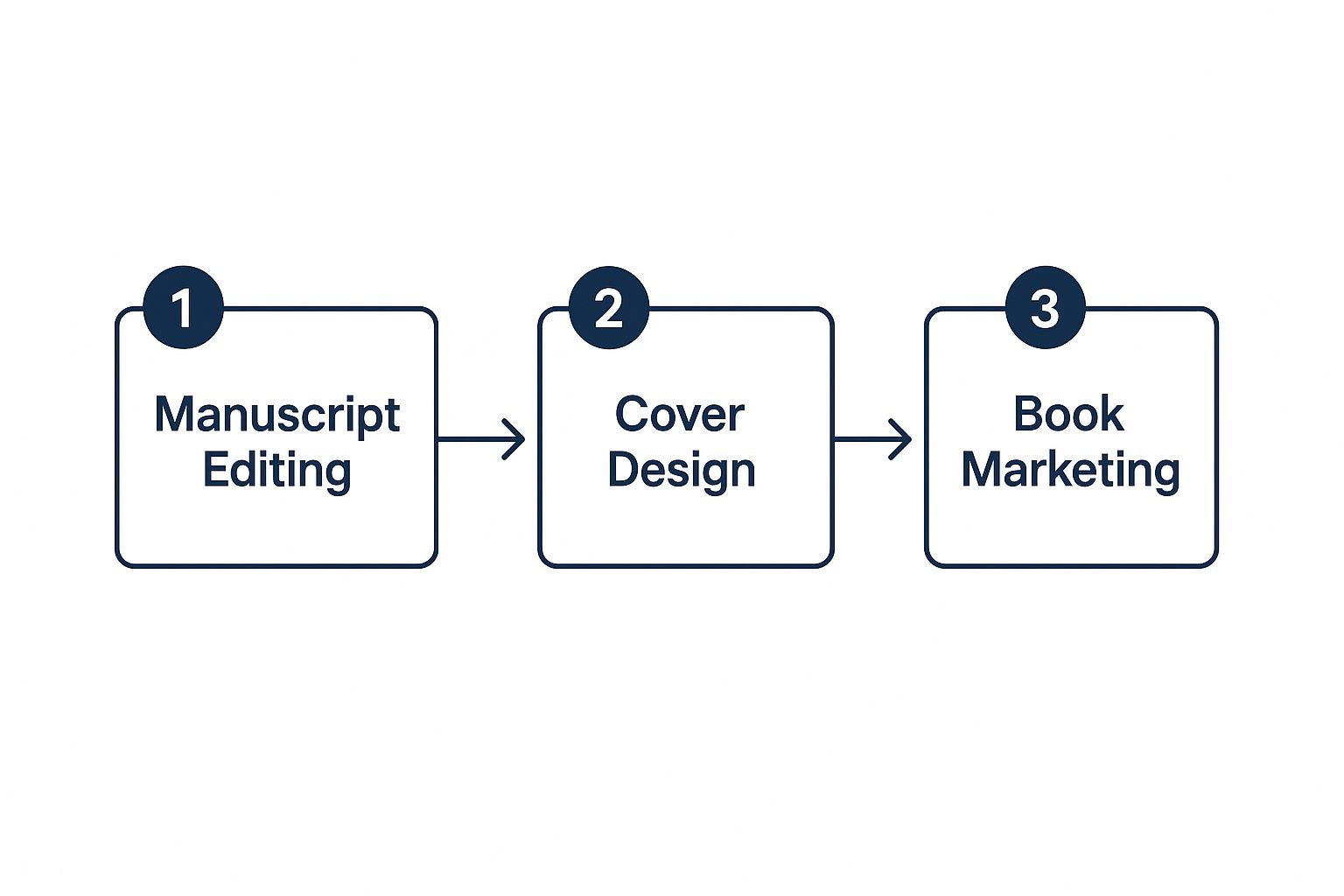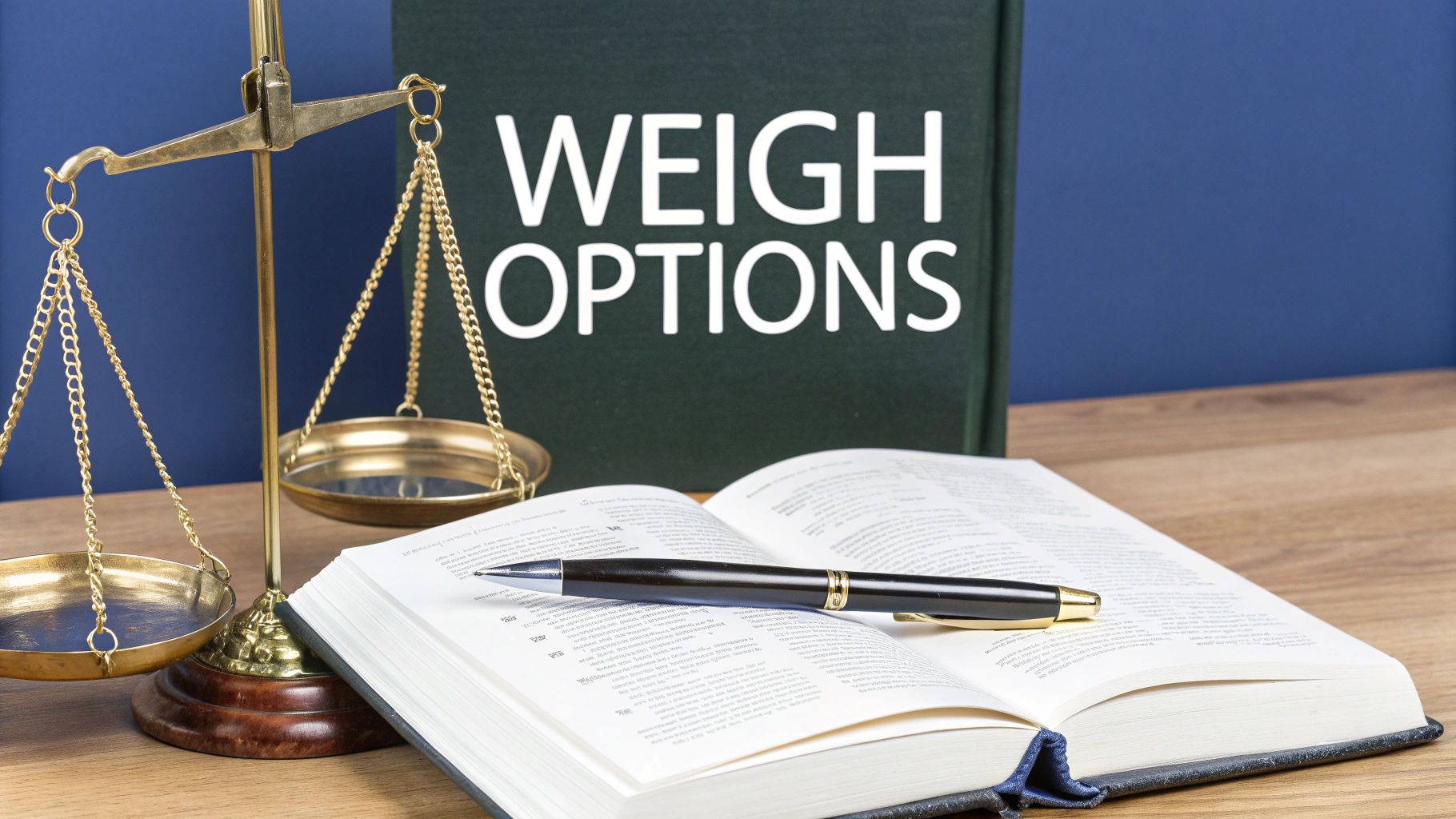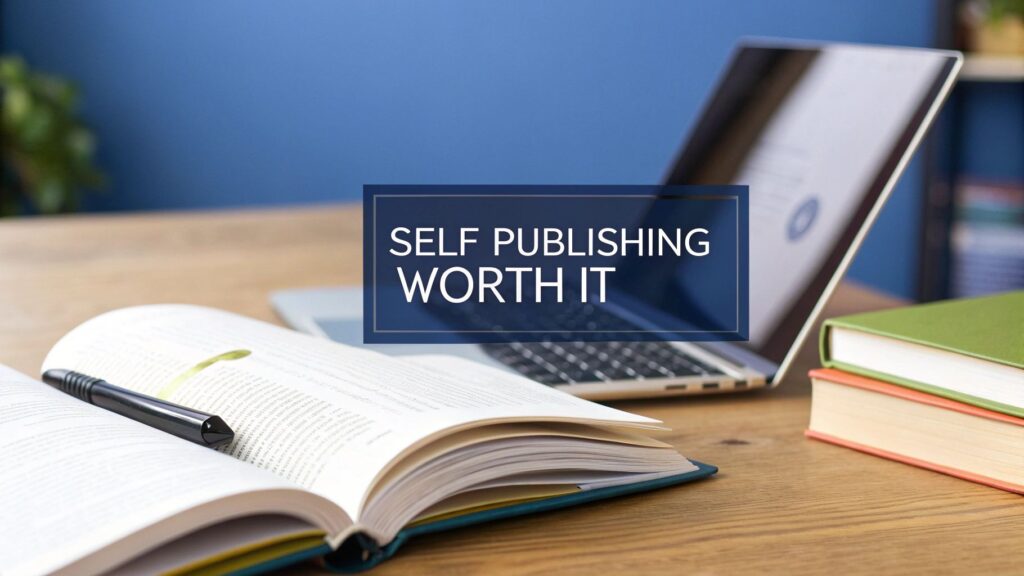So, is self-publishing actually worth it? The short answer is a resounding yes—but with a pretty big "if." It's the right move if you crave total creative control, want to earn a much bigger slice of the royalties, and have the spirit of an entrepreneur. On the flip side, if you're looking for the validation that comes with a traditional publishing deal and want to steer clear of the business side of being an author, it might not be for you.
The Modern Author's Dilemma
Choosing between self-publishing and traditional publishing isn't about picking a "better" or "lesser" path anymore. It's really about choosing the business model that aligns with your specific goals as a writer.
Think of it like this: the self-published author is a startup founder. You take on all the risk, you fund the entire venture, and you make every single call, from the cover design to the marketing plan. But the rewards—both the creative satisfaction and the financial upside—are all yours.
A traditionally published author is more like an executive working within a large corporation. You get the backing of a big institution with deep pockets and established teams for editing, distribution, and promotion. In exchange for that support system, you give up a ton of control over your own work, hand over a huge chunk of the profits, and have to work on their timeline.
Neither route is inherently superior. They just serve different kinds of ambition.
Before we dive deeper, here's a quick side-by-side comparison to help you see the core differences at a glance.
Quick Look Self Publishing vs Traditional Publishing
This table breaks down the fundamental trade-offs between the two main publishing paths, giving you a high-level view of what each one entails.
| Aspect | Self Publishing | Traditional Publishing |
|---|---|---|
| Creative Control | 100% control over content, cover, title, and timeline. | Limited control. Publisher has the final say on most creative decisions. |
| Royalties | 40-70% of the book's list price. | 5-15% of net receipts (or sometimes list price). |
| Upfront Costs | Author pays for everything: editing, design, marketing, etc. | No upfront cost. Publisher covers all production and distribution expenses. |
| Time to Market | Fast. Can be published in weeks or months. | Slow. Typically 18-24 months from signing the contract to launch. |
| Distribution | Global access via online retailers, but getting into physical bookstores is challenging. | Strong bookstore distribution and established sales channels. |
| Marketing | Author is fully responsible for building a platform and promoting the book. | Publisher provides some marketing support, but the author is still expected to do a lot. |
| Prestige | Varies. Depends on the book's success and quality. | Generally perceived as having more industry validation and prestige. |
As you can see, the choice comes down to a trade-off between control and support, and between upfront investment and long-term earning potential.
A Publishing Revolution
This whole dilemma even exists because the industry has been completely turned on its head. Authors no longer have to wait for a gatekeeper in New York to give them the nod of approval.
The rise of print-on-demand technology and online marketplaces like Amazon's Kindle Direct Publishing (KDP) has put an incredible amount of power directly into the hands of creators. This isn't just some minor trend; it's a massive shift in how books are created, sold, and read.
The question is no longer "Can I get my book published?" It's now "How should I publish my book to achieve my own version of success?"
This change allows authors to build a career entirely on their own terms, matching their publishing strategy to their personal and financial goals.
The proof is in the numbers. The growth in self-publishing has been explosive, fundamentally changing the book market. A recent industry report showed that the number of self-published titles with ISBNs jumped by 7.2% in 2023, with over 2.6 million titles released globally. That figure is more than double the output of traditional publishers, which tells you everything you need to know about this move toward author independence. You can dig into more stats and trends over at the Alliance of Independent Authors.
Ultimately, figuring out if self-publishing is worth it for you means taking a hard look at the trade-offs. You have to weigh the upfront costs against the potential for higher royalties, the freedom to create against the support of an institution, and the responsibility of marketing against having a built-in distribution network. This guide will walk you through every one of these critical factors, so you can make a decision you feel good about.
Breaking Down the Financial Equation
If you're asking whether self-publishing is worth it, we need to talk about money. But don't think of it as just an expense—it's an investment in your book, treating it like the business asset it is. To give your book a fighting chance in a crowded market, you'll need some upfront capital for the essential services that make it look professional.
This initial investment is precisely what separates a polished, high-quality book from one that looks amateurish. Trust me, readers can spot the difference a mile away, and it has a direct impact on your sales and reviews.
Core Investment Areas
So, where does the money go? Your budget will mostly be split across three critical areas. While you can find a huge range of prices out there, getting quality help in these areas is non-negotiable if you're serious about your author career.
- Professional Editing: This isn't just one thing. It's developmental editing to make sure your story works, copyediting for grammar and flow, and finally, proofreading to catch those last pesky typos.
- Cover Design: Your book cover is your number one marketing tool. It has to grab your target reader's attention instantly and look fantastic as a tiny thumbnail on a smartphone screen.
- Interior Formatting: This is all about making the inside of your book clean, readable, and perfectly set up for both ebooks and print-on-demand copies.
This handy infographic lays out the typical production flow these investments support.

As you can see, each stage builds on the last, taking you from a raw manuscript to a beautiful, marketable package that’s ready for your readers.
The Royalty Advantage
Now for the fun part. The upfront investment you make is balanced by a much, much higher potential return on every single book you sell.
This is where self-publishing really shines. Traditional publishers typically pay authors a royalty of around 10-15% per sale. With self-publishing platforms like Amazon KDP, however, you can earn anywhere from 60% to 80% of your book's list price. When you consider the average cost to produce a high-quality self-published book is between $2,940 and $5,660, you can see how much faster you can earn that money back with bigger royalty checks.
This royalty difference is a game-changer. It means a self-published author has to sell far fewer copies to break even and start making a profit compared to a traditionally published author who only gets a small slice of the pie.
If you're selling books directly from your own website, getting your head around revenue collection is vital. Using well-regarded payment processing solutions like Stripe can make managing those sales a whole lot simpler.
Calculating Your Break-Even Point
Let's put some real numbers to this. Say you invest $4,000 to get your book ready for launch, and you decide to price the ebook at $9.99 on Amazon KDP.
At a 70% royalty rate, you'd earn about $6.99 per sale (Amazon takes its cut and a tiny delivery fee). To figure out your break-even point, you just divide your total investment by what you earn on each book:
$4,000 (Your Investment) / $6.99 (Royalty Per Sale) = 573 Copies
That's it. You'd only need to sell 573 copies of your book to earn back every penny you spent. Every single sale after that is pure profit—a milestone you can reach much faster when you're in the driver's seat. For a deeper dive into the numbers, check out our guide on the https://barkerbooks.com/cost-to-self-publish-a-book/.
The Power of Creative Control

While bigger royalty checks are a huge plus, for many authors, the real answer to "is self-publishing worth it?" comes down to something you can't put a price on: total creative freedom. This is your story, your vision, and you get to protect it from start to finish—a level of control that's practically unheard of in traditional publishing.
Think about it. You pour your heart and soul into a manuscript, only for a publisher to insist you change the ending, rewrite a main character, or slap a new title on it to chase some fleeting market trend. Of course, a publisher's job is to make a book commercially successful, but their business decisions can sometimes water down what made your story special in the first place.
When you self-publish, that dynamic gets turned on its head. You're the one in charge. Every single decision rests with you.
You Are the Creative Director
As an indie author, you have the final say on every piece of your book's creation. For writers who have a specific vision they just aren't willing to compromise on, this autonomy is everything.
- Cover Design: You get to pick the artist and green-light a cover that actually feels like your book, not just one that fits a publisher's predetermined style guide.
- The Final Manuscript: The story you wrote is the one that gets published. No one can force you to kill off a character or change a crucial plot point to satisfy a sales team.
- Your Book's Title: The title is yours to choose and keep. You won’t be strong-armed into accepting a generic, keyword-stuffed title because it performed well in a focus group.
This complete ownership means the book that hits the shelves is a true, authentic representation of your art. It's your story, told exactly your way.
In traditional publishing, your book becomes a project by committee, which slows everything down. As an indie author, you are the project manager, the visionary, and the one with the final vote.
From Manuscript to Market in Record Time
Beyond the creative side of things, self-publishing gives you a massive advantage in pure speed. The traditional publishing timeline is notoriously slow. It can often take a staggering 18 to 24 months from the day you sign a contract to the day your book actually appears in a store. That glacial pace is just a side effect of a big corporate machine with jam-packed production schedules.
An indie author, on the other hand, works on their own clock. Once your manuscript is edited and formatted, you can have it live on global storefronts in a few weeks—sometimes even just a few days. This agility is a game-changer. It lets you:
- Capitalize on Timely Topics: If your book is about a current event or trend, you can get it out there while people are still talking about it.
- Maintain Momentum: For series authors, this is huge. You can release books much faster, keeping your readers hooked and hungry for the next installment.
- Control Your Launch: You pick the release date that makes sense for you, instead of getting shoved into a publisher's crowded fall or spring catalog.
This speed isn't just a convenience; it's a strategic weapon. While a traditional house does a lot of the heavy lifting, understanding what a book publisher does shows just how many layers of approval can grind the process to a halt. By taking the reins yourself, you not only protect your vision but also dictate exactly when and how your book makes its debut.
Embracing the CEO Mindset

Here's a fundamental truth about self-publishing: you're not just a writer anymore. The moment you decide to go indie, you've also become a founder, CEO, and head of marketing for a small business. Your book is the product.
This shift in thinking is make-or-break. It's often the biggest hurdle for creatives who just want to write. The word "marketing," for many, conjures up images of a pushy salesperson, but that's not what it means here.
In the indie author world, marketing is simply about creating a real connection with the people who will genuinely love your book. You aren't waiting for a gatekeeper to find your audience; you're building a community yourself, one reader at a time. It puts you in complete control, and every bit of data, every fan interaction, and every dollar earned comes directly to you.
Building Your Author Platform
So, how do you build that community? It all starts with your author platform. Think of it as your business headquarters online—the digital space you own and control, where you can connect with readers without relying on a middleman.
A solid platform really just needs three core components:
- An Email List: This is, hands down, your most critical asset. You don't own your social media followers, but you do own your email list. It's a direct line to your biggest fans, perfect for announcing a new release or sharing behind-the-scenes content.
- A Social Media Presence: The key here is not to be everywhere. Pick one or two platforms where your ideal readers hang out and focus on building a real community there. Quality over quantity.
- An Author Website: This is your professional home base. It’s the central hub where people can find all your books, learn about you, and, most importantly, sign up for that email list.
Being a successful self-published author means stepping into the role of a digital creator, which involves a lot more than just writing. If you need a roadmap for your promotional strategy, our guide on how to market your self-published book is a great place to start.
Unlocking Global Distribution
One of the most incredible developments in modern publishing is the ability to sell your book across the globe without ever having to pack a single box. The magic behind this is Print-on-Demand (POD).
Services like Amazon KDP and IngramSpark have completely changed the game for indie authors. The process is brilliantly simple:
- You upload your finished book files to their platform.
- A reader in, say, Germany or Japan orders a paperback copy from their local Amazon store.
- The platform’s nearest print facility prints a single copy of your book and ships it directly to that customer.
- You collect your royalty, with the printing cost automatically deducted.
This technology single-handedly removes the massive financial risk and logistical headaches of traditional offset printing. You can have a worldwide bookstore presence with zero inventory cost, putting you on a surprisingly level playing field with major publishing houses.
Stepping into this CEO role is a challenge, no doubt. But it’s also incredibly empowering. You get to call the shots, learn directly from your readers, and build a career that is 100% yours.
Where Self Publishing Thrives

Self-publishing isn't just a backup plan anymore. For certain corners of the book world, it's actually the most strategic path to success. The question "is self-publishing worth it?" often has less to do with the quality of your book and more to do with the audience you're trying to reach.
The digital marketplace is where indie authors truly shine. While traditional publishers still have a lock on physical bookstore shelves, the online world is a different story altogether. It's a space where indie authors can, and often do, run circles around the big guys.
This advantage comes down to formats like ebooks and audiobooks. In the digital realm, things like pricing flexibility, speed to market, and direct-to-reader engagement give self-published authors a massive edge. The global book market is projected to hit around $142.72 billion by 2025, and the digital piece of that pie is growing fast.
In fact, online book sales are on track to nearly double from $26.04 billion to $48.27 billion by 2034. This boom is powered by the incredible volume and variety that indie authors bring to the table. You can dig deeper into these numbers and see how digital sales are reshaping publishing.
The Genres Where Indies Reign Supreme
So, where is this indie dominance most obvious? It’s in specific, high-volume genres where readers are absolutely voracious. If you write in one of these categories, going indie might be the smartest career move you ever make.
Certain genres just seem tailor-made for the self-publishing model. Indie authors have discovered what these readers want and have built incredibly successful careers by giving it to them, often with rapid release schedules that traditional publishing simply can't match.
Top Genres for Self Publishing Success
The table below breaks down the genres where indie authors have consistently hit it big. This isn't just a fluke; it's a result of understanding market demand and giving loyal readers exactly what they crave.
| Genre | Key Success Factors | Audience Expectation |
|---|---|---|
| Romance | Rapid release schedules, series potential, strong tropes. | Readers buy many books a month and value author consistency over publisher prestige. |
| Sci-Fi & Fantasy | Deep world-building, long-running series, niche subgenres. | Fans are highly engaged and loyal to authors who create expansive, immersive worlds. |
| Thrillers & Mystery | Fast-paced plotting, cliffhangers, frequent new releases. | Readers love getting hooked on a series and want the next installment quickly. |
These genres thrive because the readers are loyal to authors, not publishers. They're looking for a great story, a captivating cover, and solid reviews—all things a savvy indie author can control.
The bottom line: In these genres, readers judge a book by its cover, its blurb, and its reviews, not the publisher’s logo. They just want a great story, and they want it now.
This doesn't mean you can't succeed with a literary novel or a memoir. Of course you can. But understanding where the market is hottest helps you set realistic expectations. For authors in these high-demand categories, self-publishing isn’t just a viable alternative; it's a powerful business model built for creative freedom and maximum profit.
So, Should You Do It? Making the Final Call
Deciding whether self-publishing is worth it isn't about finding a simple "yes" or "no." It's about figuring out if it's the right path for you. It all comes down to your personal goals, what you're willing to invest, and how you see yourself as an author.
Think of this as your final gut-check before you dive in. Getting real with yourself about what you want and what you can handle will show you which publishing route truly matches your vision of success.
Your Personal Publishing Checklist
Before you commit, take a minute to really think through these key areas. There are no right or wrong answers here—just what’s right for your book and your career.
-
What are your goals? Are you driven by the desire for total creative control and a direct line to your readers? Or are you aiming for the kind of prestige and validation that often comes with a traditional publishing deal?
-
What resources do you have? Be honest. Do you have the budget to hire a great editor and a professional cover designer? Just as important, do you have the time to pour into marketing, promotion, and running the business side of being an author?
-
What’s your mindset? Are you ready to be an entrepreneur? Self-publishing means you're the CEO of your book. You have to be resilient, learn to read the data, and keep pushing your work long after it first hits the virtual shelves.
Got Questions? Let's Talk Self-Publishing
Even after laying out all the pros and cons, I bet you still have a few questions rolling around in your head. That's completely normal. Let's tackle some of the big ones so you can get the clarity you need to decide if this path is really for you.
What's the Real Price Tag on Self-Publishing a Book?
You'll hear people say you can publish for free, and technically, you can upload a file without paying a dime. But if you want to create a book that looks professional and can actually compete, you’re going to need to invest in it.
Most authors who are serious about their work spend somewhere between $2,940 and $5,660.
What does that money actually go toward? It covers the absolute must-haves:
- Professional Editing: This is non-negotiable. You need a pro to polish your manuscript and catch the mistakes you've read a hundred times.
- Custom Cover Design: Your cover is your number one sales tool. It has to grab attention and look fantastic.
- Interior Formatting: A clean, easy-to-read layout for both your ebook and print versions is crucial for a good reader experience.
Try to think of this as an investment in a small business—your book—not just an expense. You're building an asset that's designed to pay you back.
Can an Indie Book Actually Hit the Bestseller List?
Yes! It happens more often than you might think, but we need to be clear about what "bestseller" really means. Can you become an Amazon bestseller? Absolutely. With a well-planned launch and some smart marketing, hitting the top of a specific Amazon category is a very realistic goal for many authors.
Now, becoming a New York Times or USA Today bestseller is a whole different ballgame. It's a much tougher climb, but it's not impossible. I've seen indie authors pull it off. At the end of the day, a book's success comes down to its quality, how well it connects with readers in its genre, and the marketing engine behind it—not who published it.
Do I Really Need to Buy My Own ISBN?
An ISBN (that's the International Standard Book Number) is like a social security number for your book—a unique ID that tracks it everywhere. Platforms like Amazon KDP will give you one for free, which sounds great, but there's a catch: they get listed as the publisher.
If you want true control and the widest possible reach for your book, you absolutely should buy your own ISBN. When you own your ISBN, you are the publisher. This gives you the freedom to use distributors like IngramSpark and opens the door to getting your book into libraries and brick-and-mortar bookstores. It's the key to unlocking your book's full potential.
Ready to turn that manuscript into a professionally published book people can buy all over the world? At BarkerBooks, our team of experts takes care of everything—the editing, the cover design, the global distribution, and the marketing—so you can get back to what you do best: writing. Learn more about our all-inclusive publishing packages at barkerbooks.com.
